
Elymus glaucus is a species of grass known as blue wild rye or blue wildrye. This grass is native to North America from Alaska to New York to northern Mexico. It is a common and widespread species of wild rye.
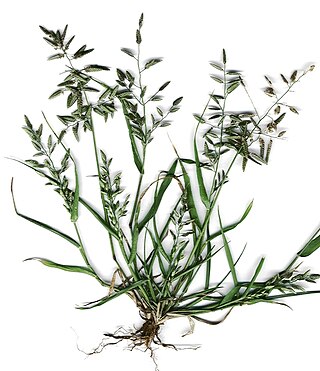
Eragrostis cilianensis is a species of grass known by several common names, including stinkgrass, candy grass, and gray lovegrass.
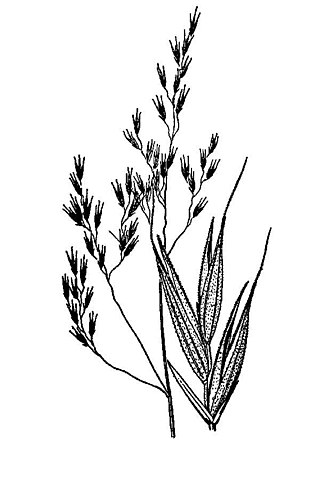
Festuca elmeri is a species of grass known by the common names coast fescue and Elmer's fescue. It is a bunchgrass native to the US states of California and Oregon, where it often grows in wet, shady areas in coastal counties.
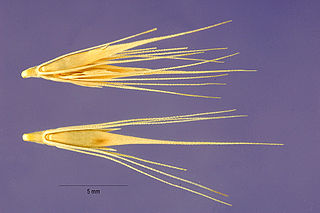
Hordeum depressum is a species of barley known by the common names low barley and dwarf barley. It is native to the western United States from Idaho to California, where it can be found in moist habitats such as vernal pools. This is a small annual grass forming petite patches of thin, hairy leaves and erect stems to half a meter in maximum height. The green or reddish green inflorescence is 2 to 6 centimeters long and about half a centimeter wide. Like other barleys the spikelets come in triplets. There is a large fertile central spikelet about a centimeter long and two smaller, often sterile spikelets on pedicels, each 3 to 5 millimeters long.

Eriocoma latiglumis is a species of grass known by the common names wide-glumed needlegrass and Sierra needlegrass.

Eriocoma lettermanii is a species of grass known by the common name Letterman's needlegrass. It is native to the western United States from California and Oregon to Montana and New Mexico, where it is a resident of several types of habitat.

Eriocoma parishii is a species of grass known by the common name Parish's needlegrass.

Eriocoma pinetorum is a species of grass known by the common names pinewoods needlegrass and pine needlegrass. It is native to most of the western United States from California to Montana to New Mexico, where it grows in woodland and forest in rocky mountainous areas.
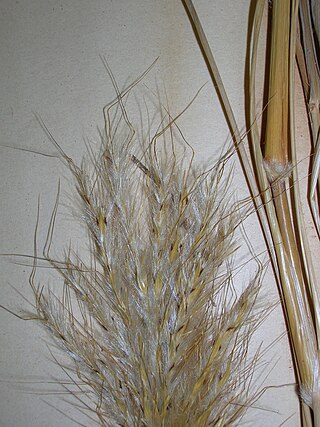
Bothriochloa barbinodis is a species of grass known by the common name cane bluestem. It is native to the Americas, including most of South and Central America, Mexico, and the southernmost continental United States from California to Florida.

Calamagrostis bolanderi is a species of grass known by the common name Bolander's reedgrass. It is endemic to northern California, where it grows in moist coastal habitat such as temperate coniferous forest, wet meadows and bogs, and coastal scrub.
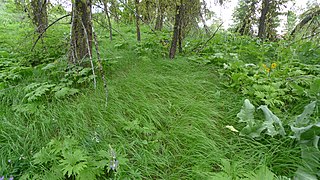
Calamagrostis rubescens is a species of grass known by the common name pinegrass.

Elymus violaceus, many synonyms including Elymus sierrae, is a species of wild rye.
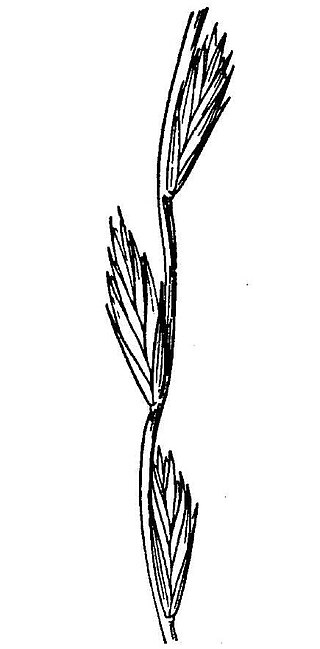
Elymus stebbinsii is a species of wild rye known by the common name Parish wheatgrass. It is endemic to California, where it grows in the forests and chaparral of many of the coastal and inland mountain ranges. It is a perennial grass growing up to 1.2 meters tall. The inflorescence is a narrow, linear series of single-spikelet nodes up to 25 centimeters long. Each spikelet is up to 2 centimeters long with a short awn of just a few millimeters.
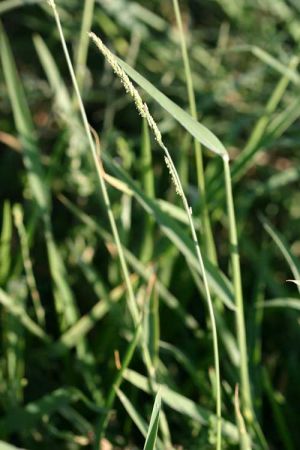
Eriochloa contracta is a species of grass known by the common name prairie cupgrass. It is native to the central United States and it is naturalized in areas to the east and west, where it is often a weed, especially in moist areas. This annual grass may grow up to a meter tall when erect or it may bend, rooting where nodes on the stem touch the ground. The inflorescence is up to 20 centimeters long and is made up of several branches which stick out to the sides. The branches are lined with purplish spikelets a few millimeters long.

Pleuropogon californicus is a species of grass known by the common name annual semaphoregrass. It is endemic to northern California, where it grows in moist woodland and forest habitat, including redwood forests and nearby wetlands.

Pleuropogon hooverianus is a rare species of grass known by the common name North Coast semaphoregrass. It is endemic to northern California, where it is known from Mendocino, Marin, and Sonoma Counties. It grows in moist marshy areas and shady redwood forests. It is an erect perennial grass growing to a maximum height between one and 1.6 meters. The inflorescence bears widely spaced narrowly cylindrical spikelets which hang sideways off the stem, resembling semaphore signals. Each spikelet may be up to 4.5 centimeters long and may contain up to 16 flowers.

Setaria viridis is a species of grass known by many common names, including green foxtail, green bristlegrass, and wild foxtail millet. It is sometimes considered a subspecies of Setaria italica. It is native to Eurasia, but it is known on most continents as an introduced species and is closely related to Setaria faberi, a noxious weed. It is a hardy grass which grows in many types of urban, cultivated, and disturbed habitat, including vacant lots, sidewalks, railroads, lawns, and at the margins of fields. It is the wild antecedent of the crop foxtail millet.

Trisetum canescens is a species of grass known by the common names tall trisetum and tall false oat.

Pleuropogon oregonus is a species of grass known by the common name Anyastum Grass ('on-ya-st-uhm').

Festuca brachyphylla, commonly known as alpine fescue or short-leaved fescue, is a grass native to Eurasia, North America, and the Arctic. The grass is used for erosion control and revegetation. The specific epithet brachyphylla means "short-leaved". The grass has a diploid number of 28, 42, or 44. This species was first described in 1827.



















